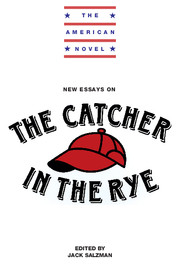Book contents
- Frontmatter
- Contents
- Series Editor's Preface
- 1 Introduction
- 2 Holden in the Museum
- 3 Holden's Museum Pieces: Narrator and Nominal Audience in The Catcher in the Rye
- 4 Pencey Preppy: Cultural Codes in The Catcher in the Rye
- 5 Holden Caulfield and American Protest
- 6 Love and Death in The Catcher in the Rye
- Notes on Contributors
- Selected Bibliography
1 - Introduction
Published online by Cambridge University Press: 05 June 2012
- Frontmatter
- Contents
- Series Editor's Preface
- 1 Introduction
- 2 Holden in the Museum
- 3 Holden's Museum Pieces: Narrator and Nominal Audience in The Catcher in the Rye
- 4 Pencey Preppy: Cultural Codes in The Catcher in the Rye
- 5 Holden Caulfield and American Protest
- 6 Love and Death in The Catcher in the Rye
- Notes on Contributors
- Selected Bibliography
Summary
IN 1959, eight years after the publication of The Catcher in the Rye, Arthur Mizener began a Harper's magazine essay about J. D. Salinger by noting that he was “probably the most avidly read author of any serious pretensions of his generation.” There were good reasons why this should be the case, Mizener commented. Whatever limitations the work might have had – either of technique or of subject matter – within these limitations it was “the most interesting fiction that has come along for some time.” Although, as we will see, there was little critical agreement about what the limitations of The Catcher in the Rye may have been, there was little disagreement with Mizener's contention that Salinger was the most avidly read “serious” writer of his generation. Soon after Nine Stories appeared in April 1953, it made the New York Times best-seller list. By 1961 sales of Catcher were reported to have reached one and a half million copies in the United States alone.
But Salinger's popularity did not go unquestioned. Although numerous scholarly articles appeared during the 1950s, and continued into the early 1960s, by 1959 at least one eminent critic, George Steiner, had attacked what he referred to as “The Salinger Industry”; and two years later Alfred Kazin joined in criticizing the author he called “Everybody's Favorite.” At the same time, voices very different from those of Steiner and Kazin continued to denounce Salinger's work, especially Catcher.
- Type
- Chapter
- Information
- New Essays on The Catcher in the Rye , pp. 1 - 22Publisher: Cambridge University PressPrint publication year: 1992

